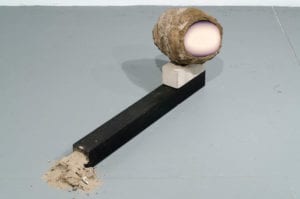To stand out as an artist is a difficult task, to stand out and make a name/career for yourself is another perilous task, and to do so with sculpture, in an age so focused on photography, new media, painting, and the like is yet another task that genuinely displays the talent and expertise of a true artist. For MaryKate Maher sculpture and collage are all in a day’s work. Her work exudes feeling and purpose, while retaining this museum-worthy quality. Her work utilizes natural and man-made objects like nothing we’ve ever seen before, it’s hard not to marvel at her work.
Art Zealous had the chance to interview MaryKate about her work, her favorite things, and how she got her start.

Art Zealous: What’s your favorite animal?
MaryKate Maher: Mini pot-bellied pig, but I think my spirit animal is a sleepy cat.
AZ: Paper or plastic?
MM: Paper.
AZ: What is your phone background right now?
MM: Some generic setting with too many apps to cover anyway. Boring, I know. My screen also has bubbles in the protective layer and some type of studio gunk on it, so I can’t really see anything anyway.
AZ: What led you to the arts?
MM: My parents. They would sign my sister and me up for weekend art classes when we were young. I got into painting and drawing pretty early on. A lot of puffy paint and bedazzling on canvases. My mom also worked in a public school that had an awesome art/shop class. When my school would have days off, I would go to work with her and hang out in the art room for the day. I just kept going until I finally went to art school.
AZ: What drove you or inspired you towards sculpting?
MM: I’ve always gravitated to textures and materiality. My background in painting slowly evolved into cutting out panels and making them free standing. I don’t consider myself strictly a sculptor. Collage is also a big part of my work as well. What connects the two is that strong sense of texture and materiality. I make work that is meant to be felt physically. I aim to make you feel something in your body and working in sculpture seems the most direct route to that.
AZ: What is your process like when sculpting? Do you go off the cuff, or plan out everything in rigorous detail?
MM: It’s about 50/50. I usually start by making sketches, planning out forms and certain details; however, when I start working in the round, I allow some intuition to take over. It can be a slow and deliberative process. Many times I will arrive at something like my original idea only to find it lacking. In this working/reworking moment, other ideas emerge that I can then cannibalize into new works.
AZ: You utilize a lot of natural minerals and resources in your work, what draws you to those resources?
MM: I take a lot of inspiration from the natural environment: geological formations, erosion, mineral deposits. I don’t necessarily use natural materials, but I do look at natural materials and then I look for ways to make the resulting works feel as if they have emerged from the natural world.

AZ: Which artists do you derive motivation from?
MM: Too many to name since there are a lot of artists making really great work right now. A handful of old and new are Joseph Beuys, Isamu Noguchi, Andra Ursata, Thomas Houseago, Arlene Shechet.
AZ: Many of your pieces are of such unusual shapes and forms, like “Cavern.” How do you ultimately decide a shape is the way you want it to be?
MM: The more awkward and strange the more correct it feels. This goes back to the earlier question about my process. A flat drawing of a form can feel completely different from the same form I sculpted. I usually find myself going back into a work and chopping chunks off, or squishing down a side to make it feel “right.” I also think my physical body is lopsided, so maybe it’s more about my inability to make something purposely symmetrical and I gravitate towards that unusual lump instead.
AZ: How do you find a balance between man-made materials and natural ones?
MM: Most of my natural materials and collections are in my house on display like random rocks and pieces of earth I collect from every place I visit. One piece is a seashell that attached itself to a little chunk of Styrofoam and they’re permanently fused together. That’s the sort of weird balance I try to find. My studio work attempts to evoke a familiarity with natural forms. Not in order to re-create it, like stage props, but rather to forge a symbiotic affinity with natural.

AZ: How does tension come into play in your work?
MM: I find there are different moments of tension in the work. It elicits tension to approach something almost but not quite natural. Formally, I use weight and balance to create tension as well as texture, allowing really rough surfaces that look unfinished or ill-conceived to rub up against the more polished. A lot of it comes back to materiality.
AZ: Finally, what’s your dream place to display your work?
MM: The Palais de Tokyo for an indoor setting, the Bonneville Salt Flats for an outdoor setting.
top image// “ersetzen” Socrates Sculpture Park, 2010, images by Bilyana Dimitrova



